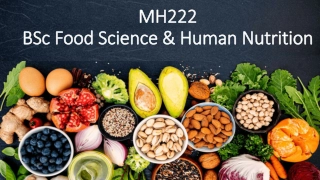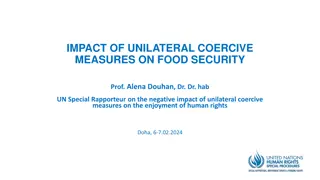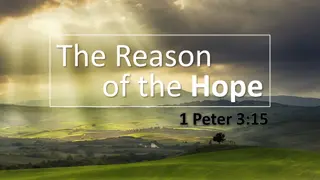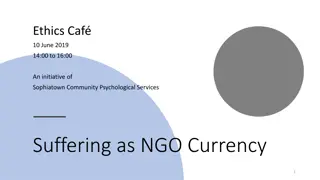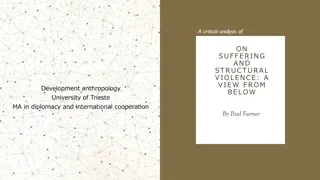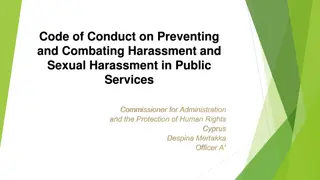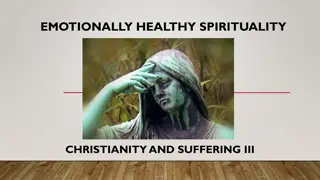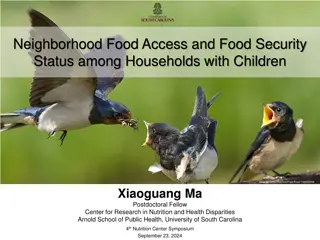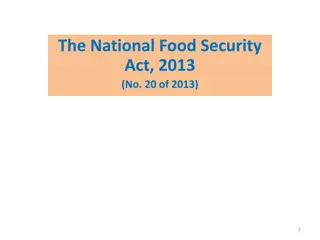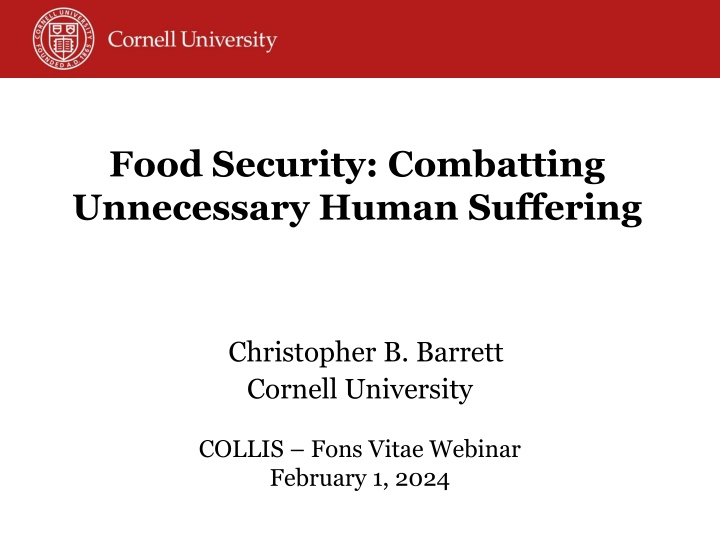
Food Security: Combating Unnecessary Human Suffering
Food security as a human right is intrinsic to human flourishing, where access and affordability play a critical role. The triple burden of malnutrition and the high hidden costs of food underscore the challenges faced in ensuring all individuals have access to sufficient, safe, and nutritious food. Key lessons highlight the need to develop technologies, institutions, and policies to accelerate sustainable food production and boost supply growth, with a particular focus on Africa.
Download Presentation

Please find below an Image/Link to download the presentation.
The content on the website is provided AS IS for your information and personal use only. It may not be sold, licensed, or shared on other websites without obtaining consent from the author. If you encounter any issues during the download, it is possible that the publisher has removed the file from their server.
You are allowed to download the files provided on this website for personal or commercial use, subject to the condition that they are used lawfully. All files are the property of their respective owners.
The content on the website is provided AS IS for your information and personal use only. It may not be sold, licensed, or shared on other websites without obtaining consent from the author.
E N D
Presentation Transcript
Food Security: Combatting Unnecessary Human Suffering Christopher B. Barrett Cornell University COLLIS Fons Vitae Webinar February 1, 2024
Food security is a human right Food security is a human right (Art. 25 1948 UDHR), intrinsic to human flourishing Food security exists if and only if all people at all times have physical, social, and economic access to sufficient, safe and nutritious food that meets their dietary needs and food preferences for an active and healthy life (1996 World Food Summit definition, emphasis added)
Access and affordability Starvation is the characteristic of some people not having enough food to eat. It is not the characteristic of there being not enough food to eat. (emphasis in original) - Opening sentences, Amartya Sen, 1981 Poverty & Famines Global food production is at record highs. So are human population and incomes. Since ~2000 food demand growth has outpaced supply expansion. Prices have therefore risen. And since ~2014, so has hunger and malnutrition. Food insecurity arises mainly b/c poor people cannot afford a healthy diet.
Triple burden of malnutrition Inability to afford a healthy diet manifests in 3 ways: 1. Undernourishment (insufficient calories/protein): 700-800 mn 2. Obesity/overweight: >2 bn Source: Shekar and Popkin (2020) 3. Micronutrient (mineral/vitamin) deficiencies: >3 bn
High hidden costs of food And even higher prices mask the true cost of food. Agrifood systems have considerable forced and child labor, even slavery (esp. fisheries, cocoa, cotton) Responsible for considerable environmental damages 20-35% of GHG emissions, most freshwater use, soils degradation, air and water pollution, biodiversity loss Even larger health costs due to unhealthy diets and zoonoses (ag accounts for >50% of zoonoses). Estimated hidden costs ~$11-13 trillion/yr (FAO)!!
Key lessons 1 Must develop: - technologies, institutions, policies to accelerate sustainable production of healthy foods. Must boost supply growth to meet (and slow) demand growth. - social safety nets to safeguard all humans right to food. Supply side is necessary but insufficient. - pay special attention to Africa, home to 60-75% of future food demand growth. Source: Vollset et al. Lancet 2020
Key lessons 2 - while also addressing disparities in rich countries. Huge inter-group differences in the US. - 2/3 US residents never experience food insecurity. - ~1/2 of those who become food insecure regain FS quickly - But chronic (and often severe) food insecurity is real and structural: - FI prevalence is 15x higher for HH w/ WOC w/o HS degree vs. w/ WM college grad head. And FI severity is 33x greater! Source: Lee, Barrett & Hoddinott (2024)
Summary Food security remains a systemic challenge, globally and in the US. Too often thought of as an ag/production problem. And food assistance is too often stigmatized, which impedes honoring the hungry s recognized rights and dignity. As Laudato Si emphasized, food insecurity is a social justice/poverty problem, with grave labor, health, and environmental consequences.
Central question What does a preferential option for the poor imply for prioritization among many different food security policy levers (e.g., gov t food assistance, private charity, animal/plant genetics, dietary change, etc.)?

